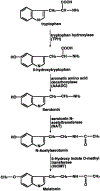Trace elements in human physiology and pathology. Copper
- PMID: 14652164
- PMCID: PMC6361146
- DOI: 10.1016/s0753-3322(03)00012-x
Trace elements in human physiology and pathology. Copper
Abstract
Copper is a trace element, important for the function of many cellular enzymes. Copper ions can adopt distinct redox states oxidized Cu(II) or reduced (I), allowing the metal to play a pivotal role in cell physiology as a catalytic cofactor in the redox chemistry of enzymes, mitochondrial respiration, iron absorption, free radical scavenging and elastin cross-linking. If present in excess, free copper ions can cause damage to cellular components and a delicate balance between the uptake and efflux of copper ions determines the amount of cellular copper. In biological systems, copper homeostasis has been characterized at the molecular level. It is coordinated by several proteins such as glutathione, metallothionein, Cu-transporting P-type ATPases, Menkes and Wilson proteins and by cytoplasmic transport proteins called copper chaperones to ensure that it is delivered to specific subcellular compartments and thereby to copper-requiring proteins.
Figures
References
-
- Linder MC. Biochemistry of copper. New York: Plenum Press; 1991.
-
- Walker WR. The results of a copper bracelet clinical trial and subsequent studies In: Sorenson J Jr, editor. Inflammatory diseases and copper. Totowa (NJ): Humana; 1982. p. 469–78.
-
- Turnlund JR, Keyes WR, Erson HL,Acord LL. Copper absorption and retention in young men at three levels of dietary copper using the stable isotope 65Cu. Am J Clin Nutr 1989;49:870–8. - PubMed
-
- Scott KC, Turnlund JR. Compartment model of copper metabolism in adult men. J Nutr Biochem 1994;5:342–50.
-
- Linder MC, Hazegh-Azam M. Copper biochemistry and molecular biology. Am J Clin Nutr 1996;63:797S–811S. - PubMed
Publication types
MeSH terms
Substances
Grants and funding
LinkOut - more resources
Full Text Sources


